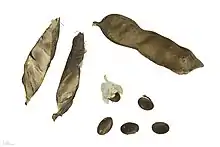Canavalia rosea
Canavalia rosea is a species of flowering plant of the genus Canavalia in the pea family, Fabaceae, that has a pantropical distribution.[2] Common names include beach bean, bay bean, seaside jack-bean, coastal jack-bean,[1] and MacKenzie bean.[2]


| Canavalia rosea | |
|---|---|
 | |
| Scientific classification | |
| Kingdom: | |
| (unranked): | |
| (unranked): | |
| (unranked): | |
| Order: | |
| Family: | |
| Genus: | |
| Species: | C. rosea |
| Binomial name | |
| Canavalia rosea | |
| Synonyms | |
|
Canavalia maritima Thouars | |
Description
Coastal jack-bean is a trailing, herbaceous vine that forms mats of foliage. Stems reach a length of more than 6 m (20 ft) and 2.5 cm (0.98 in) in thickness. Each compound leaf is made up of three leaflets 5.1–7.6 cm (2.0–3.0 in) in diameter, which will fold themselves when exposed to hot sunlight. The flowers are purplish pink and 5.1 cm (2.0 in) long. The flat pods are 10.2–15.2 cm (4.0–6.0 in) long and become prominently ridged as they mature. The buoyancy of the seeds allows them to be distributed by ocean currents.[2] The plant seems to contain L-Betonicine.
Habitat and range
C. rosea inhabits upper beaches, cliffs, and dunes throughout the world's coastal tropics. It is highly salt-tolerant and prefers sandy soils.[2]
References
- "Canavalia rosea". Germplasm Resources Information Network (GRIN). Agricultural Research Service (ARS), United States Department of Agriculture (USDA). Retrieved 2010-12-04.
- Christman, Steve (2004-01-14). "#857 Canavalia rosea". Floridata. Retrieved 2010-12-04.
External links
 Media related to Canavalia rosea at Wikimedia Commons
Media related to Canavalia rosea at Wikimedia Commons Data related to Canavalia rosea at Wikispecies
Data related to Canavalia rosea at Wikispecies- Canavalia rosea at JSTOR Plant Science